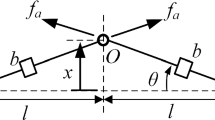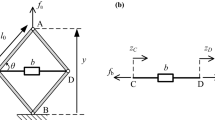Abstract
This study proposes an inerter-based nonlinear passive joint device and investigates its performance in suppression of vibration transmission in coupled systems. The joint device comprises an axial inerter and a pair of lateral inerters creating geometric nonlinearity, with the nonlinear inertance force being a function of the relative displacement, velocity, and acceleration of the two terminals. Both analytical approximations based on the harmonic balance method and numerical integration are used to obtain the steady-state response amplitude. Force transmissibility and time-averaged energy flow variables are used as performance indices to evaluate the vibration transmission in the coupled system, with subsystems representing the dominant modes of interactive engineering structures. The effects of adding the proposed joint to the force-excited subsystem or to the coupling interface of subsystems on suppression performance are examined. It is found that the insertion of the inerter-based nonlinear joint can shift and bend response peaks to lower frequencies, substantially reducing the vibration of the subsystems at prescribed frequencies. By adding the joint device, the level of vibration force and energy transmission between the subsystems can be attenuated in the range of excitation frequencies of interest. It is shown that the inerter-based nonlinear joint can be used to introduce an anti-peak in the response curve and achieve substantially lower levels of force transmission and a reduced amount of energy transmission between subsystems. This work provides an in-depth understanding of the effects of inerter-based nonlinear devices on vibration attenuation and benefits enhanced designs of coupled systems for better dynamic performance.


















Similar content being viewed by others
Data availability statement
The results presented in this work can be replicated by implementing the equations presented in this paper. All relevant equations have been included to enable readers to replicate the results.
References
Yang, J., Xiong, Y.P., Xing, J.T.: Dynamics and power flow behaviour of a nonlinear vibration isolation system with a negative stiffness mechanism. J. Sound Vib. 332(1), 167–183 (2013)
Chedjou, J.C., Fotsin, H.B., Woafo, P., Domngang, S.: Analog simulation of the dynamics of a van der Pol oscillator coupled to a Duffing oscillator. IEEE Trans. Circuits Syst. I Fundam. Theory Appl. 48(6), 748–757 (2001)
Schwingshackl, C.W., Di Maio, D., Sever, I., Green, J.S.: Modeling and validation of the nonlinear dynamic behavior of bolted flange joints. J. Eng. Gas Turbines Power 135(12), 122504 (2013)
Jalali, H., Ahmadian, H., Mottershead, J.E.: Identification of nonlinear bolted lap-joint parameters by force-state mapping. Int. J. Solids Struct. 44(25–26), 8087–8105 (2007)
Liu, X.C., Cui, F.Y., Jiang, Z.Q., Wang, X.Q., Xu, L., Shang, Z.X., Cui, X.X.: Tension–bend–shear capacity of bolted-flange connection for square steel tube column. Eng. Struct. 201, 109798 (2019)
Yang, J.S.: Hybrid active and passive control of a very large floating beam structure. Nonlinear Dyn. 87(3), 1835–1845 (2017)
Stanton, S.C., Culver, D., Mann, B.P.: Tuning inertial nonlinearity for passive nonlinear vibration control. Nonlinear Dyn. 99(1), 495–504 (2020)
Smith, M.C.: Synthesis of mechanical networks: the inerter. IEEE Trans. Autom. Control 47(10), 1648–1662 (2002)
Chen, M.Z., Papageorgiou, C., Scheibe, F., Wang, F.C., Smith, M.C.: The missing mechanical circuit element. IEEE Circuits Syst. Mag. 9(1), 10–26 (2009)
Glover, A.R., Smith, M.C., Houghton, N.E., Long, P.J.G.: Force-controlling hydraulic device. International Patent Application No: PCT/GB2010/001491 (2009)
Smith, M.C., Wang, F.C.: Performance benefits in passive vehicle suspensions employing inerters. Veh. Syst. Dyn. 42(4), 235–257 (2004)
Li, Y., Jiang, J.Z., Neild, S.: Inerter-based configurations for main-landing-gear shimmy suppression. J. Aircr. 54(2), 684–693 (2017)
Lazar, I.F., Neild, S.A., Wagg, D.J.: Using an inerter-based device for structural vibration suppression. Earthquake Eng. Struct. Dynam. 43(8), 1129–1147 (2014)
Yang, J.: Force transmissibility and vibration power flow behaviour of inerter-based vibration isolators. In: Journal of Physics: Conference Series, vol. 744(1), pp. 012234 (2016)
Yang, J., Jiang, J.Z., Zhu, X., Chen, H.: Performance of a dual-stage inerter-based vibration isolator. Procedia Eng. 199, 1822–1827 (2017)
Dong, Z., Yang, J., Meng, H., Chronopoulos, D.: Suppression of vibration transmission between oscillators coupled with an inerter-based joint. In: Proceedings of the 11th International Conference on Structural Dynamics, Athens, Greece, 23–26 November 2020, pp. 1521–1528. European Association for Structural Dynamics Publishing (2020)
Zhu, C., Yang, J., Rudd, C.: Vibration transmission and power flow of laminated composite plates with inerter-based suppression configurations. Int. J. Mech. Sci. 190, 106012 (2020)
Dong, Z., Chronopoulos, D., Yang, J.: Enhancement of wave damping for metamaterial beam structures with embedded inerter-based configurations. App. Acoust. 178, 108013 (2021)
Zhang, R., Zhao, Z., Pan, C., Ikago, K., Xue, S.: Damping enhancement principle of inerter system. Struct. Control Health Monit. 27(5), e2523 (2020)
Yang, J., Xiong, Y.P., Xing, J.T.: Power flow behaviour and dynamic performance of a nonlinear vibration absorber coupled to a nonlinear oscillator. Nonlinear Dyn. 80(3), 1063–1079 (2015)
Bichiou, Y., Hajj, M.R., Nayfeh, A.H.: Effectiveness of a nonlinear energy sink in the control of an aeroelastic system. Nonlinear Dyn. 86(4), 2161–2177 (2016)
Yan, Z., Ragab, S.A., Hajj, M.R.: Passive control of transonic flutter with a nonlinear energy sink. Nonlinear Dyn. 91(1), 577–590 (2018)
Papageorgiou, C., Houghton, N.E., Smith, M.C.: Experimental testing and analysis of inerter devices. J. Dyn. Syst. Meas. Control 131(1), 011001 (2009)
Papageorgiou, C., & Smith, M. C.: Laboratory experimental testing of inerters. In Proceedings of the 44th IEEE Conference on Decision and Control, Seville, Spain, 15 December 2005, pp. 3351–3356. IEEE Publishing (2005)
Gonzalez-Buelga, A., Lazar, I.F., Jiang, J.Z., Neild, S.A., Inman, D.J.: Assessing the effect of nonlinearities on the performance of a tuned inerter damper. Struct. Control Health Monit. 24(3), e1879 (2017)
Yang, J., Jiang, J.Z., Neild, S.A.: Dynamic analysis and performance evaluation of nonlinear inerter-based vibration isolators. Nonlinear Dyn. 99(3), 1823–1839 (2020)
Yang, J., Shi, B., Rudd, C.: On vibration transmission between interactive oscillators with nonlinear coupling interface. Int. J. Mech. Sci. 137, 238–251 (2018)
Goyder, H.G.D., White, R.G.: Vibrational power flow from machines into built-up structures, part I: introduction and approximate analyses of beam and plate-like foundations. J. Sound Vib. 68(1), 59–75 (1980)
Goyder, H.G.D., White, R.G.: Vibrational power flow from machines into built-up structures, Part II: Wave propagation and power flow in beam-stiffened plates. J. Sound Vib. 68(1), 77–96 (1980)
Goyder, H.G.D., White, R.G.: Vibrational power flow from machines into built-up structures, Part III: power flow through isolation systems. J. Sound Vib. 68(1), 97–117 (1980)
Langley, R.S.: Analysis of power flow in beams and frameworks using the direct-dynamic stiffness method. J. Sound Vib. 136(3), 439–452 (1990)
Clarkson, B.L.: Estimation of the coupling loss factor of structural joints. Proc. Inst. Mech. Eng. Part C Mech. Eng. Sci. 205(1), 17–22 (1991)
Cuschieri, J.M.: Structural power-flow analysis using a mobility approach of an L-shaped plate. J. Acoust. Soc. Am. 87(3), 1159–1165 (1990)
Mace, B.R., Shorter, P.J.: Energy flow models from finite element analysis. J. Sound Vib. 233(3), 369–389 (2000)
Wang, Z.H., Xing, J.T., Price, W.G.: A study of power flow in a coupled plate–cylindrical shell system. J. Sound Vib. 271(3–5), 863–882 (2004)
Xiong, Y.P., Xing, J.T., Price, W.G.: Power flow analysis of complex coupled systems by progressive approaches. J. Sound Vib. 239(2), 275–295 (2001)
Xing, J.T., Price, W.G.: A power–flow analysis based on continuum dynamics. Proc. Royal Soc. Lond. Ser. A Math. Phys. Eng. Sci. 455(1982), 401–436 (1999)
Ji, L., Mace, B.R., Pinnington, R.J.: A power mode approach to estimating vibrational power transmitted by multiple sources. J. Sound Vib. 265(2), 387–399 (2003)
Xiong, Y.P., Xing, J.T., Price, W.G.: A power flow mode theory based on a system’s damping distribution and power flow design approaches. Proc. Royal Soc. A Math. Phys. Eng. Sci. 461(2063), 3381–3411 (2005)
Yang, J., Xiong, Y.P., Xing, J.T.: Nonlinear power flow analysis of the Duffing oscillator. Mech. Syst. Signal Process. 45(2), 563–578 (2014)
Yang, J., Xiong, Y.P., Xing, J.T.: Vibration power flow and force transmission behaviour of a nonlinear isolator mounted on a nonlinear base. Int. J. Mech. Sci. 115, 238–252 (2016)
Krack, M., Gross, J.: Harmonic balance for nonlinear vibration problems. Springer, New York (2019)
Moussi, E.H., Bellizzi, S., Cochelin, B., Nistor, I.: Nonlinear normal modes of a two degrees-of-freedom piecewise linear system. Mech. Syst. Signal Process. 64, 266–281 (2015)
Ibrahim, R.A.: Recent advances in nonlinear passive vibration isolators. J. Sound Vib. 314, 371–452 (2008)
Acknowledgements
This work was supported by National Natural Science Foundation of China [Grant numbers, 12172185, 51839005].
Author information
Authors and Affiliations
Corresponding author
Ethics declarations
Conflict of interest
We have no conflicts of interest to declare.
Additional information
Publisher's Note
Springer Nature remains neutral with regard to jurisdictional claims in published maps and institutional affiliations.
Appendix: Property of the power transmission ratio
Appendix: Property of the power transmission ratio
When the inerter-based joint is added at position Q, the power transmission ratio \({R}_{t}\) from subsystems S1 to S2 is not sensitive to changes in the inertance \(\lambda_{0}\) and \(\lambda_{1}\) as shown in Figs. 15b and 18b. Here, the reasons are demonstrated with mathematical derivations for the case when the inerter-based joint is added at position Q, and the lateral inerters are with \(\lambda_{1} = 0\). Note that Eq. (6) can be rearranged as:
where \(\tilde{X}_{1}\) and \(\tilde{\Delta }\) denotes the complex amplitude of the response of mass \(m_{1}\) and that of the relative displacement amplitude. According to Eq. (39a) and (39b), the expression of response amplitude can be derived as:
The transmitted force to subsystem S2 can be expressed by:
The time-averaged input power and transmitted power over a period of oscillation are:
where \({*}\) denotes the complex conjugate. The power transmission ratio from subsystem one to subsystem two is defined as:
Based on Eqs. (40)–(43), the power transmission ratio \(R_{t}\) can be calculated:
where \(\lambda_{0}\) is eliminated suggesting that the change in \({\lambda }_{0}\) will not affect the power transmission ratio from subsystem S1 to subsystem S2.
Rights and permissions
About this article
Cite this article
Dong, Z., Shi, B., Yang, J. et al. Suppression of vibration transmission in coupled systems with an inerter-based nonlinear joint. Nonlinear Dyn 107, 1637–1662 (2022). https://doi.org/10.1007/s11071-021-06847-9
Received:
Accepted:
Published:
Issue Date:
DOI: https://doi.org/10.1007/s11071-021-06847-9




